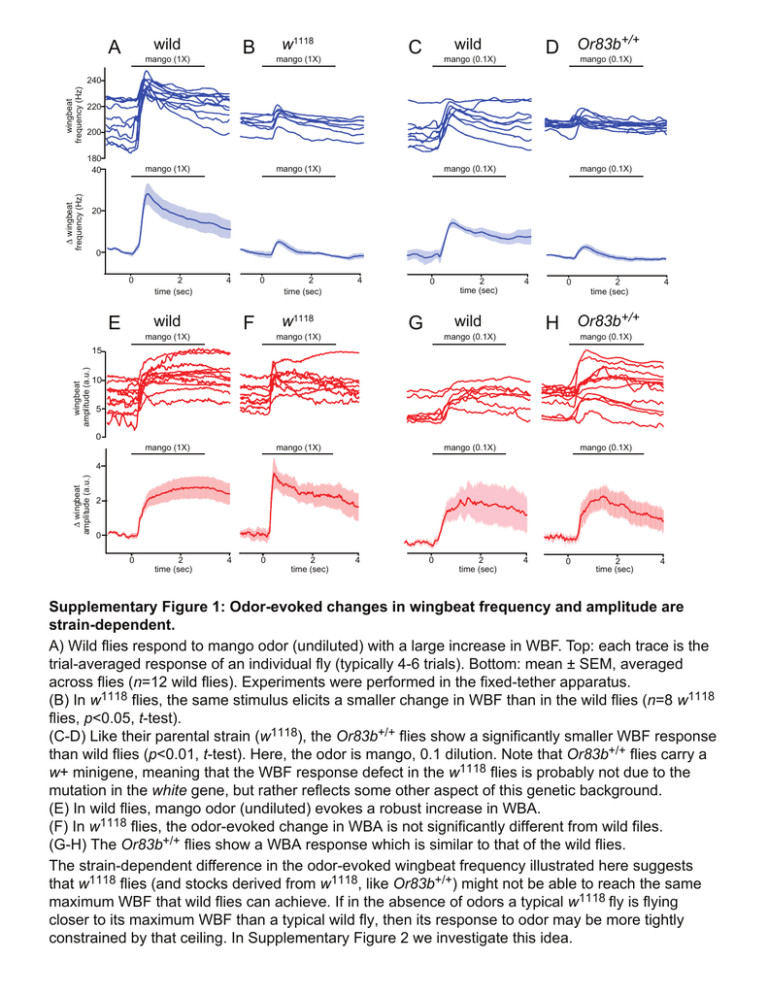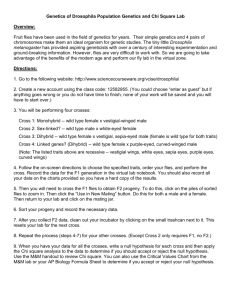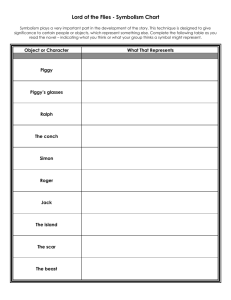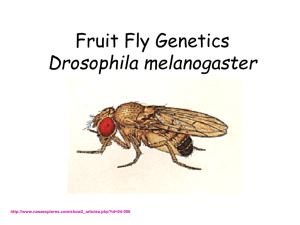time (sec)
advertisement

wild A w1118 B mango (1X) mango (1X) +/+ D Or83b mango (0.1X) wild C mango (0.1X) wingbeat frequency (Hz) 240 220 200 ∆ wingbeat frequency (Hz) 180 40 mango (1X) mango (1X) mango (0.1X) mango (0.1X) 20 0 0 E 2 time (sec) 4 0 F wild mango (1X) 2 time (sec) 4 0 G w1118 mango (1X) 2 time (sec) 4 0 2 time (sec) 4 H Or83b+/+ wild mango (0.1X) mango (0.1X) wingbeat amplitude (a.u.) 15 10 5 0 mango (1X) mango (1X) mango (0.1X) mango (0.1X) ∆ wingbeat amplitude (a.u.) 4 2 0 0 2 time (sec) 4 0 2 time (sec) 4 0 2 time (sec) 4 0 2 time (sec) 4 Supplementary Figure 1: Odor-evoked changes in wingbeat frequency and amplitude are strain-dependent. A) Wild flies respond to mango odor (undiluted) with a large increase in WBF. Top: each trace is the trial-averaged response of an individual fly (typically 4-6 trials). Bottom: mean ± SEM, averaged across flies (n=12 wild flies). Experiments were performed in the fixed-tether apparatus. (B) In w1118 flies, the same stimulus elicits a smaller change in WBF than in the wild flies (n=8 w1118 flies, p<0.05, t-test). (C-D) Like their parental strain (w1118), the Or83b+/+ flies show a significantly smaller WBF response than wild flies (p<0.01, t-test). Here, the odor is mango, 0.1 dilution. Note that Or83b+/+ flies carry a w+ minigene, meaning that the WBF response defect in the w1118 flies is probably not due to the mutation in the white gene, but rather reflects some other aspect of this genetic background. (E) In wild flies, mango odor (undiluted) evokes a robust increase in WBA. (F) In w1118 flies, the odor-evoked change in WBA is not significantly different from wild files. (G-H) The Or83b+/+ flies show a WBA response which is similar to that of the wild flies. The strain-dependent difference in the odor-evoked wingbeat frequency illustrated here suggests that w1118 flies (and stocks derived from w1118, like Or83b+/+) might not be able to reach the same maximum WBF that wild flies can achieve. If in the absence of odors a typical w1118 fly is flying closer to its maximum WBF than a typical wild fly, then its response to odor may be more tightly constrained by that ceiling. In Supplementary Figure 2 we investigate this idea. wingbeat frequency (Hz) 160 200 240 baseline wingbeat frequency (Hz) 80 w1118 40 0 C240 160 200 240 baseline wingbeat frequency (Hz) wild D240 wingbeat frequency (Hz) 0 B wingbeat frequency (Hz) 40 E 220 200 5 10 15 wingbeat amplitude (a.u.) w1118 220 200 5 wild 260 10 15 wingbeat amplitude (a.u.) 0 1 2 time (sec) 3 220 180 F wingbeat frequency (Hz) wild ∆ wingbeat frequency (Hz) ∆ wingbeat frequency (Hz) A 80 260 10 a.u. w1118 220 180 10 a.u. Supplementary Figure 2: Strains differ in their maximum wingbeat frequency. (A) In wild flies, the odor-evoked increase in wingbeat frequency is negatively correlated with baseline WBF on a trial-to-trial basis. Each point represents different trial (pooled trials from 12 flies, 78 trials total, r=-0.81, p<0.05). Odor is mango (undiluted). Experiments were performed in the fixedtether apparatus. (B) Similarly, in w1118 flies, the odor-evoked increase in wingbeat frequency is also negatively correlated with the baseline wingbeat frequency (pooled trials from 8 flies, 42 trials total, r=-0.89, p<0.05). However, the linear relationship (solid line) is shifted down as compared to the wild strain (compare dashed line), suggesting that w1118 flies are constrained by a lower maximum stroke frequency. (C) Instantaneous wingbeat frequency is plotted against instantaneous wingbeat amplitude for a single typical trial in a wild fly (baseline period in black, time after odor onset encoded in color). The odor-evoked surge begins with a large increase in wingbeat frequency, accompanied by an increase in wingbeat ampltude. Wingbeat frequency then reaches a maximum, after which the fly may be obtaining further increases in flight force by trading wingbeat frequency for wingbeat ampltude. (D) In a typical w1118 fly, the odor-evoked surge in wingbeat frequency reaches a smaller maximum value as compared to the wild fly. (E) Analogous plots for each wild fly show the same trends as in (C). Dashed line indicates the x-intercept of the fitted line in (A). (F) Same as (E) but for each w1118 fly. Solid line indicates the x-intercept of the fitted line in (B). Taken together, these results imply that different fly strains have different available kinematic ranges for flight modulation. A optical signal audio signal 5 msec wingbeat frequency (Hz) B 240 odor audio optical 230 220 210 -3 0 time (sec) 3 6 Supplementary Figure 3: Comparison of wingbeat frequency measurements obtained with a photodide and with a microphone in the rotatable-tether apparatus. (A) Top trace shows the optical signals obtained from a photosensitive detector beneath the fly (see cartoon in Fig. 1A, right detector only), while the bottom trace shows the audio signals obtained from a microphone positioned next to the fly (see cartoon in Fig. 5A). Both signals show the same periodicity. (B) Measurements obtained simultaneously using these two methods are in good agreement. ∆ wingbeat frequency (Hz) A odor 10 fixed tether 5 rotatable tether 0 0 4 C odor 1 baseline wingbeat frequency (Hz) average normalized ∆ wingbeat frequency B 2 time (sec) 0 0 time (sec) 1 220 200 rotatable tether fixed tether Supplementary Figure 4: The odor-evoked increase in wingbeat frequency is similar in the fixed- and rotatable-tether apparatus. (A) Odors produced a similar change in WBF in the fixed- and rotatable-tether conditions. Differences in response peak were not statistically significant (n=8 fixed-tether, 6 rotatabletether, p>0.2, t-test). Values are ± SEM, averaged across flies. Odor is mango (undiluted), flow rate is 550 mL/min for both the fixed- and rotatable-tether setups. (B) A comparison between the mean time course of WBF responses in the two setups. Each fly’s response was normalized to the same maximum before averaging across flies. (C) Baseline WBF was similar in the two setups. Each point is a different fly, horizontal lines are averages across flies. air wingbeat frequency (Hz) A odor 240 220 200 180 240 220 200 180 wingbeat amplitude (a.u.) B -4 -2 0 2 4 6 -4 -2 0 2 time (sec) 4 6 14 8 2 14 8 2 Supplementary Figure 5: Effect of the air stream on wingbeat frequency and amplitude. These representative traces show the period of air stream onset and offset surrounding the odor stimulus. Flow rate is 1100 ml/min. (A) Mean wingbeat frequency in three individual flies (top) and averaged across all flies (bottom). (B) Mean wingbeat amplitude in three individual flies (top) and averaged across all flies (bottom). Note that wingbeat frequency tends to increase transiently at air-on and air-off. Wingbeat amplitude tends to decrease at air-on and increase at air-off. 275 ml/min 550 ml/min odor odor odor 2200 ml/min odor odor 30 0 3 0 0 2 4 -2 time (sec) 25 240 210 180 150 0 250 750 1250 1750 flow rate (ml/min) 2 4 -2 0 2 4 -2 C 10 4 5 2 0 0 250 750 1250 1750 flow rate (ml/min) 0 baseline wingbeat amplitude (a.u.) 50 baseline wingbeat frequency (Hz) B 0 2 4 -2 D 0 2 4 1000 latency of WBF response (msec) -2 ∆ wingbeat frequency (Hz) 1650 ml/min 1100 ml/min ∆ wingbeat amplitude (a.u.) ∆ wingbeat amplitude (a.u.) ∆ wingbeat frequency (Hz) A 500 0 0 1000 2000 flow rate (ml/min) Supplementary Figure 6: Effect of flow rate on the odor-evoked flight surge. (A) Higher flow rates (corresponding to higher air speeds) produce larger odor-evoked changes in WBF and WBA. Also note that within each trial at high flow rates, the fly’s baseline (pre-odor) flight force decreases steadily after the air flow is turned on at t = - 4 sec. (The dip in WBF/WBA halfway through the odor pulse was a consistent finding at 1650 ml/min, but the reason for this is not clear.) (B) Increasing flow rate increases ∆WBF but decreases baseline (pre-odor) WBF. (C) Increasing flow rate increases odor-evoked ∆WBA, but has little effect on baseline WBA. (D) The latency of the WBF response is strongly influenced by the flow rate. Odor is mango (undiluted), flies are wild strain. All values are mean ± SEM, averaged across flies. High flow rates are useful in olfaction experiments because they produce good trial-to-trial consistency in the dynamics of the odor stimulus. However, these results suggest that an intermediate flow rate (~1100 ml/min) is optimal for these experiments. At this flow rate, baseline WBF and WBA are relatively steady, yet odor-evoked flight modulations are also crisp. ∆ wingbeat amplitude (a.u.) ∆ wingbeat frequency (Hz) A B wild 40 40 paraffin oil 20 20 0 0 paraffin oil 4 2 0 0 0 2 time (sec) paraffin oil paraffin oil 4 2 -2 w1118 4 -2 0 2 time (sec) 4 Supplementary Figure 7: The odor solvent alone does not affect wingbeat frequency or amplitude. (A) The odor solvent alone (paraffin oil, J.T. Baker, VWR #JTS894) has no effect on the wingbeat frequency or amplitude of the wild strain flies (n=7). (B) Similar negative results were obtained for w1118 flies (n=6). Data in this figure come from the fixed-tether apparatus. right - left wingbeat amplitude (a.u.) ethyl acetate (10-5) 10 5 0 -5 -4 -2 0 2 4 time (sec) Supplementary Figure 8: Ethyl acetate can evoke fictive turning in the fixed-tether apparatus. In the fixed-tether apparatus, the difference between right and left wingbeat amplitude values is a proxy for the fly’s yaw torque. This plot shows the (right - left) difference plotted over time in a series of trials from a representative fly, with each trial displayed in a different color. Note that during the baseline period, the fly executes fast changes in the relative amplitude of the right and left wingbeats (so-called ”body saccades”). The odor ethyl acetate (10-5) decreases this saccade rate, indicating a more steady fictive upwind orientation. Similar results were observed with other flies. These results show that although this odor stimulus does not elicit a change in wingbeat frequency or amplitude in wild flies in the fixed-tether setup (Fig. 3), it does elicit other flight behaviors. This demonstrates that the fly can perceive the stimulus, consistent with the fact that it produces a large field potential response in the antennae and palps.





